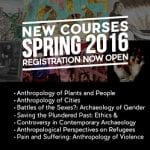Biography
Brigitte Kovacevich received her BA from the University of Arizona and PhD from Vanderbilt University in 2006. Before coming to University of Central Florida as Assistant Professor in 2015, she taught at Southern Methodist University, Yale University, and the University of Virginia. She was tenured and promoted to Associate Professor at UCF in 2018. Dr. Kovacevich is a Mesoamerican Archaeologist who works in Guatemala and focuses on the Maya. Her great passion is for Household Archaeology and the investigation of how households were articulated with and foundational for larger social processes like the rise of social inequality, the maintenance of power, and collapse of political systems. She investigates these processes primarily through the analysis of stone tools and adornments with publications on jade production, distribution, and chemical composition with Dumbarton Oaks Research Library and Collection, Trustees for Harvard University (in 2015 and 2021), Heritage Science, Ancient Mesoamerica, and Art of the Ancient Americas at the Dallas Museum of Art, edited by Michelle Rich published by Yale University Press. Kovacevich has co-directed a project at the Maya site of Holtun, Guatemala investigating the origins of social complexity that resulted in publications in PLOS ONE, Journal of Archaeological Research: Reports, Advances in Archaeological Practice. She currently co-directs a project analyzing lidar data from over 500km2 of the landscape within the Maya Biosphere in Guatemala as part of the Pacunam Lidar Initiative. Her work has been funded by the National Geographic Society and National Science Foundation, American Philosophical Society, Pacunam, The Hitz Foundation, among others. Dr. Kovacevich is currently accepting students.
Research Specialization
- Mesoamerican Archaeology
- Household Archaeology
- Lithic Analysis
- Gender and Social Identity
- Nonindustrial Economic Systems.
Dr. Kovacevich is currently director of an archaeological project at the site of Holtun, Guatemala, located in the central lakes region of the department of the Peten, Guatemala. The site is situated approximately 35 km southwest of Tikal, 12 km to the south of Yaxha, and only 1 km from the present day village of La Maquina. The formal site of Holtun consists of a monumental epicenter built atop a natural karstic hill positioned along a roughly northeast-southwest linear axis. The approximate area of the epicenter is 970 x 815 m. The epicenter consists of 14 groups and nearly 100 structures and has an established Middle Preclassic through Late Classic period occupation (Fialko 1999, 2002; Ponciano 1995; Kovaceivch et al. 2010).
Goals of this research are to elucidate organization of political authority during a lesser known epoch in Maya prehistory, the Middle Preclassic period (600-300 BC). This is a time of great social change in the Maya lowlands that included the rise of social and political complexity, the first monumental architecture, and possibly the first kings. Many questions remain about this time period, why did the Maya begin to live in nucleated settlements and cities? Why and how did political power develop? And, how were these changes related to community ritual? Excavations are focused on the earliest ceremonial architecture at the site, as well as residential structures. This research has been generously funded by the National Geographic Society, National Science Foundation.
Fialko, Vilma
2002 Documentacion del Arte Escultorico y Pictorico de la Acropolis Triadica de Holtun, Peten. Manuscript in archive, DEMOPRE. IDAEH, PRONAT-TRIANGULO-DEMOPRE: Guatemala.
1999 Sangre, Sudor, y Lagrimas: Investigaciones de Arqueologia Regionalm no. 10, Holtun, Ixtinto, y La Naya. Manuscript in archive, PRONAT-TRIANGULO, IDAEH: Guatemala.
Kovacevich, Brigitte, Patricia Rivera Castillo, Michael G. Callaghan, and Melvin Rodrigo Guzman
2010 Proyecto Arqueologico Holtun. Informe, Temporada 2010. IDAEH, Guatemala.
Ponciano, Erick M.
1995 Recientes Descubrimientos en el Departamento de Petén: Sitio Arqueológico Holtun, Aldea La Máquina, Flores. En VIII Simposio de Investigaciones Arqueológicas en Guatemala, 1994 (edited by J.P. Laporte and H. Escobedo), pp.484-492. Museo Nacional de Arqueología y Etnología, Guatemala.
Working with Dr. Kovacevich
I strive to share my passion for my research through graduate training in diverse theoretical and methodological approaches in classroom, field, and laboratory settings. Some of my current research interests include lithic analysis, gender and social identity, household archaeology, chemical compositional analysis, production technology, and social inequality. I engage in collaborative projects with these topics through a variety of methods including ceramic and lithic analysis, geoarchaeology, landscape archaeology, faunal analysis, as well as ethnohistoric and ethnographic research and share these engagements with our graduate students with hands-on experiences that provide them with a basis for conducting scientific archaeological research. In the past my students have received grants from National Geographic Society’s Young Explorer Program, Sigma-Xi grants-in-aid of research, Fulbright IIE, and National Science Foundation Dissertation Enhancement Program.
Dr. Kovacevich is looking for graduate students with an interest in:
- Maya Archaeology
- Household Archaeology
- Lithic Analysis
- Chemical Compositional Analysis
- Technology and Replication Studies
- Social Inequality
- Gender and Social Identity
Examples of projects conducted by Dr. Kovacevich’s students:
- Chemical characterization of obsidian using pXRF
- Chemical characterization of soils from plaza surfaces
- Foodways as a marker of social identity in Honduras
- Lithic replication studies
- Replication of ancient jade working techniques
- GIS and mapping



